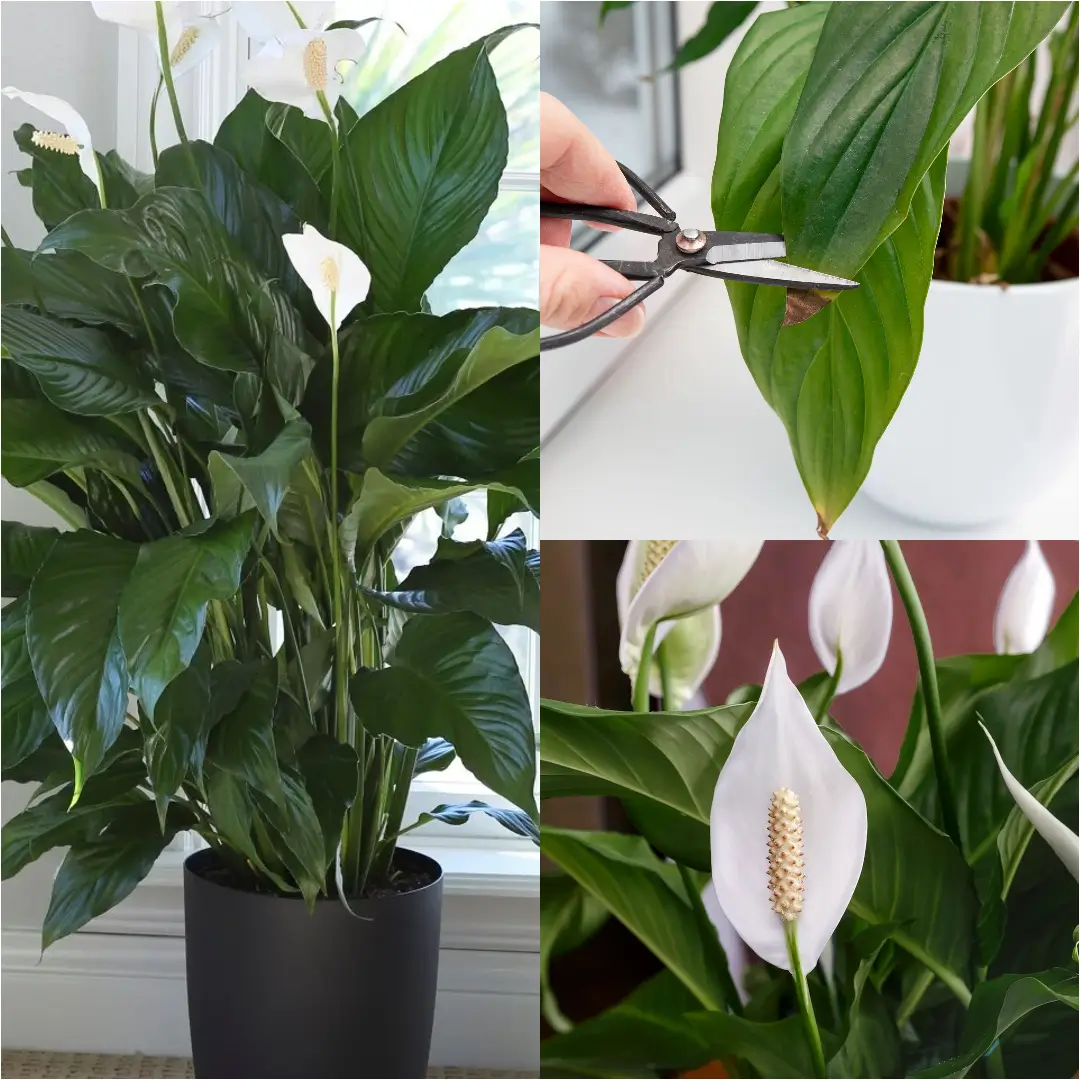If you’re looking for a houseplant that’s low-maintenance, visually striking, and beneficial for indoor air quality, care for peace lily might be perfect for you. Known for its dark green, glossy leaves and stunning white flowers, the peace lily (Spathiphyllum wallisii) is a popular choice for plant enthusiasts of all skill levels. But what’s the secret to keeping this beauty thriving? Don’t worry, I’ve got you covered! In this guide, we’ll dive deep into how to care for peace lily, covering everything from light requirements to pest control. Whether you’re a seasoned green thumb or just starting your plant parent journey, these tips will help you nurture a vibrant peace lily at home. With the right care for peace lily, you’ll enjoy not only its aesthetic appeal but also its ability to purify the air in your living space.
What Is a Peace Lily?
Before we jump into the details of care for peace lily, let’s first understand what a peace lily is. Despite its name, the peace lily isn’t actually a lily at all! Instead, it belongs to the arum family, making it a close relative of other houseplants like the Swiss cheese plant (Monstera) and the dumb cane (Dieffenbachia). Peace lilies are native to Central America and thrive in warm, humid environments, which makes them ideal for indoor spaces like bathrooms or kitchens. So, if you’re ready to create a mini tropical oasis, the care for peace lily will be your perfect guide to ensuring a thriving, healthy plant.
Light Requirements for Peace Lily
Bright, Indirect Light Is Key
The first step in mastering care for peace lily is understanding its lighting needs. Peace lilies thrive in bright, indirect light. You know that gorgeous natural light streaming through your window? That’s exactly what your peace lily craves—but don’t place it directly in that sunlight! Too much exposure to direct light can cause the edges of the leaves to turn brown, and no one wants a crispy plant. Imagine your peace lily lounging under a shade umbrella on a sunny day; it enjoys the warmth but not the harshness of direct rays.
Can Peace Lilies Survive in Low Light?
Yes, they can! If you’ve got a slightly darker corner in your home, your peace lily won’t mind too much. However, keep in mind that while peace lilies can survive in low light, they won’t bloom as much. If you’re eager for those stunning white flowers, aim for a spot that gets bright, indirect light. After all, even plants need a little bit of sunshine to shine!
Watering Your Peace Lily
Keeping the Soil Moist
Watering is one of the most important aspects of how to care for peace lily. Peace lilies like their soil to be moist but not soggy. A good rule of thumb is to water your peace lily when the top few centimeters of soil feel dry to the touch. But be careful! Overwatering can lead to root rot, and no one wants a waterlogged plant.
What Happens If Your Peace Lily Wilts?
If you’ve been busy and forgot to water your peace lily (hey, it happens!), you’ll know it because the plant will wilt. Don’t panic! The good news is that peace lilies are resilient. Give it a good drink, and within a few hours, you’ll notice the leaves perking back up. It’s like magic! But this doesn’t mean you should let it dry out too often. Stick to a regular watering schedule to keep your plant happy.
Humidity: Creating a Tropical Environment
Why Peace Lilies Love Humidity
Did you know that peace lilies are native to tropical rainforests? That’s why they thrive in humid environments. As part of your care for peace lily, if the air in your home is dry—especially during winter months—your peace lily might need a little extra love. Misting the leaves with water occasionally can help replicate that rainforest humidity they love so much. By ensuring the right humidity levels, you’ll keep your peace lily happy and flourishing.
Best Places in Your Home for a Peace Lily
A humid room, like a bathroom or kitchen, is the perfect spot for your peace lily. These areas naturally have higher humidity, which will keep your plant feeling right at home. If you don’t want to move your peace lily around, simply mist the leaves every few days to maintain moisture.
Feeding Your Peace Lily
Time for a Nutrient Boost
When it comes to feeding, peace lilies aren’t too demanding, but as part of your care for peace lily, a little extra nourishment during the growing season goes a long way. In spring and summer, feed your peace lily every two weeks with a liquid houseplant fertilizer. This regular feeding will encourage healthy growth and help the plant produce those lovely white flowers that make it so popular. By following these feeding guidelines, you’ll enhance the overall vitality of your peace lily.
Avoid Overfeeding
While it’s important to feed your peace lily, you don’t want to overdo it. Too much fertilizer can lead to yellowing leaves or even damage the plant’s roots. Always follow the instructions on your fertilizer, and when in doubt, less is more!
Deadheading: Removing Spent Blooms
Keeping Your Plant Looking Its Best
Peace lilies naturally drop their flowers after they’ve bloomed, but you can help your plant conserve energy by deadheading spent blooms. To do this, simply cut the flower stem close to the base of the plant once the bloom starts to fade. Deadheading not only keeps your peace lily looking neat but also promotes new growth.
Cleaning the Leaves
Dust can accumulate on your peace lily’s leaves, which can block sunlight and reduce its ability to photosynthesize. Wipe the leaves down regularly with a damp cloth or use a plant-safe leaf spray. Your peace lily will thank you!
Repotting Your Peace Lily
When to Repot
Unlike some other houseplants, peace lilies don’t need to be repotted often. In fact, they do quite well when their roots are a bit crowded. However, if you notice your peace lily wilting more frequently, even with regular watering, it might be time for a new pot. As a general rule, repot every two to three years.
Choosing the Right Pot and Soil
When it’s time to repot, choose a pot that’s only slightly larger than the current one—about one-third larger is perfect. Too big a pot can lead to overwatering issues. Use peat-free, multi-purpose compost to give your peace lily a nutrient boost, and water thoroughly after repotting.
Pest Control for Peace Lilies
Common Pests to Watch For
Although peace lilies are relatively pest-resistant, they’re not entirely immune. One of the most common issues is fungus gnats, which can appear when the soil is too moist. These tiny flies thrive in damp environments, so if you see them buzzing around, it’s time to reduce your watering.
How to Get Rid of Pests
To break the lifecycle of fungus gnats as part of your care for peace lily, allow the soil to dry out a bit between waterings. You can also use homemade traps—place a shallow dish of sweet-smelling liquid like wine or beer near the plant to attract and drown the gnats. If the problem persists, consider using an organic pesticide to effectively manage the issue. Following these steps will help ensure that your peace lily remains healthy and pest-free.
Solving Common Peace Lily Problems
Yellow Leaves
If you notice your peace lily’s leaves turning yellow, it’s usually a sign of overwatering. Let the soil dry out a bit before watering again. Occasionally, an old leaf will yellow as part of the plant’s natural aging process—this is normal and nothing to worry about.
Brown Leaf Edges
Brown edges on the leaves are often caused by too much direct sunlight. Move your peace lily to a spot with bright, indirect light to avoid scorching its delicate leaves.
Ideal Placement for Peace Lily
Finding the Perfect Spot
Since peace lilies love humidity and bright, indirect light, the best place to keep them is in rooms like the bathroom or kitchen. These areas naturally offer the warmth and moisture peace lilies need to thrive. Avoid placing your peace lily near doors, windows, or fireplaces where it could be exposed to cold drafts.
Potting a Peace Lily
How to Pot a Peace Lily
When potting your peace lily, select a container that’s only one-third larger than the plant’s rootball. Fill the pot two-thirds of the way with peat-free compost, place your peace lily inside, and fill in the remaining space around the rootball. Water well and allow the pot to drain before setting it in its new home.
Caring for a peace lily is both simple and rewarding. With the right light, consistent watering, and a bit of attention to humidity, you’ll have a thriving plant that not only adds beauty to your home but also helps purify the air. Care for peace lily doesn’t have to be complicated—just remember to keep the soil moist, avoid direct sunlight, and mist the leaves for that tropical touch. Whether you’re new to houseplants or a seasoned pro, the peace lily is a fantastic choice for brightening up any indoor space.
FAQs
How do you take care of a peace lily indoors?
To care for peace lily indoors, place it in bright, indirect light and water it when the top layer of soil dries out. As part of your care for peace lily routine, maintain humidity by misting the leaves occasionally, especially in dry environments. Keep it away from cold drafts and direct sunlight, and feed it with a liquid houseplant fertilizer every two weeks during the growing season. By following these guidelines, you’ll create a thriving environment for your peace lily to flourish.
How often should you water a peace lily?
You should water a peace lily about once a week or when the top few centimeters of soil feel dry as part of your care for peace lily routine. If the plant begins to wilt, that’s a sign it needs watering, and it will typically perk back up after a good drink. Keeping an eye on the moisture level in the soil is crucial for maintaining the health and vibrancy of your peace lily.
How do I make my peace lily happy?
To keep your peace lily happy, proper care for peace lily includes providing it with bright, indirect light, maintaining a regular watering schedule, and increasing humidity by misting its leaves. Place it in a warm, humid room like a bathroom or kitchen for ideal conditions, and make sure to repot it every few years for optimal growth. With the right care for peace lily, your plant will thrive and continue to enhance your indoor space.
Do peace lilies need full sun?
No, peace lilies do not need full sun. In fact, direct sunlight can damage their leaves, causing them to develop brown edges. Part of proper care for peace lily is ensuring they thrive in bright, indirect light or even low-light conditions. However, always avoid placing them in direct sunlight, as it can be too harsh for their delicate foliage.


